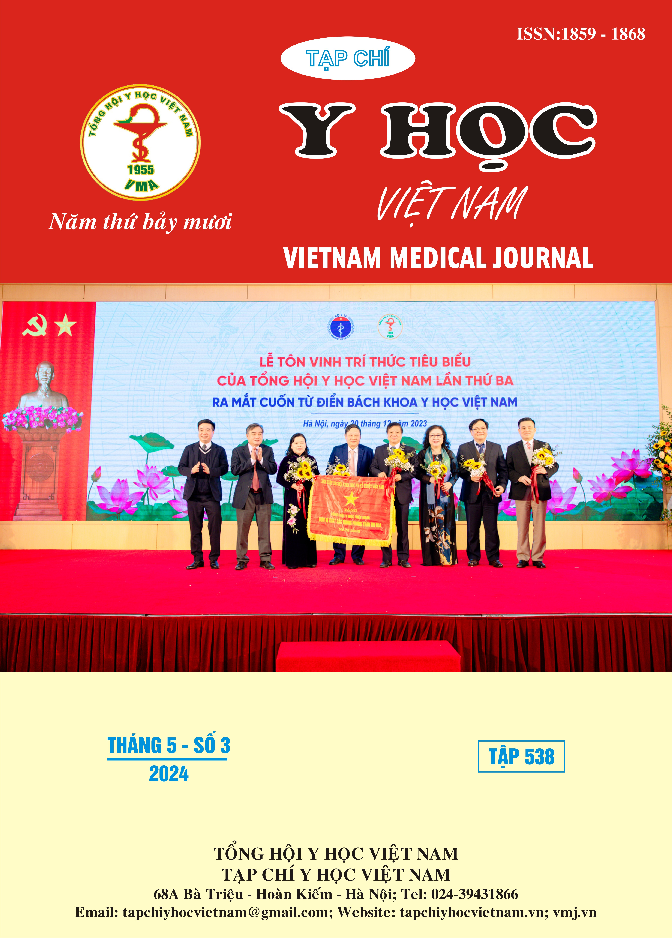COMPARING RESULTS OF COMPLETE RUPTURE OF THE ACHILLES TENDON USING THE TECHNIQUE OF PERCUTANEOUS AND OPEN REPAIR
Main Article Content
Abstract
Objectives: To compare the results and complications of surgical treatment of patients with complete rupture of the Achilles tendon due to trauma using the percutaneous and open repair technique. Subjects and methods: In a retrospective control study, 60 adult patients with complete rupture of the Achilles tendon due to trauma, treated surgically at 108 Military Central Hospital from January 2017 to August 2022, were divided into two groups: 30 patients underwent percutaneous repair of Achilles tendon, and 30 patients underwent open repair of the Achilles tendon. Results: The ATRS score, the range of plantar flexion and dorsal flexion of the ankle joint, and the rate of re-rupture of the Achilles tendon were similar in the two treatment groups. However, patients with percutaneous repair had a lower rate of wound infection, could stand on tiptoes sooner, had a shorter length of stay in the hospital, sooner resumed work, and had more aesthetic scars. Conclusion: The functional outcomes are similar in the two treatment groups, which are one year postoperative. However, percutaneous repair has the advantages of infection, length of stay hospital in hospital, resumed work, and aesthetic scars.
Article Details
Keywords
surgery, completed rupture, Achilles tendon, trauma.
References
2. Mafulli N (1999). Current concepts review: rupture of the Achilles tendon. J. Bone Joint Surg, 81: 1019-1036.
3. Leppilahti J., Orava S. (1998). Total Achilles tendon rupture. Sports Med, 2: 79-100.
4. Yang B, Liu Y, Kan S, Zhang D, Xu H, Liu F, Ning G, Feng S. (2017). Outcomes and complications of percutaneous versus open repair of acute Achilles tendon rupture: A meta-analysis. International Journal of Surgery, 40:178-186.
5. Khan, R.J., Fick, D., Keogh, A., Crawford, J., Brammer, T. and Parker, M., (2005). Treatment of acute Achilles tendon ruptures a meta-analysis of randomized, controlled trials. JBJS, 87(10):2202-2210.
6. Oliva F, Marsilio E, Asparago G, Giai Via A, Biz C, Padulo J, et al. (2022). Achilles tendon rupture and dysmetabolic diseases: a multicentric, epidemiologic study. J Clin Med, 11(13):3698.
7. Pajala A., Kangas J., Ohtonen P. et al (2002). Rerupture and deep infection following treatment of total Achilles tendon rupture. The journal of bone & joint surgery, 84(11): 2016-2021.
8. Caolo KC, Eble SK, Rider C, Elliott AJ, Demetracopoulos CA, Deland JT, Drakos MC, Ellis SJ. (2021). Clinical Outcomes and Complications With Open vs Minimally Invasive Achilles Tendon Repair. Foot Ankle Orthop, 29; 6(4):24730114211060063.
9. Webb J, Moorjani N, Radford M. (2000). Anatomy of the sural nerve and its relation to the Achilles tendon. Foot & Ankle International / American Orthopaedic Foot and Ankle Society and Swiss Foot and Ankle Society, 21(6): 475-7.
10. Hammad M.E., Fayed A.M., Ayoub M.A., et al. (2023). Early satisfactory results of percutaneous repair in neglected Achilles tendon rupture. BMC Musculoskelet Disord, 24: 446.


